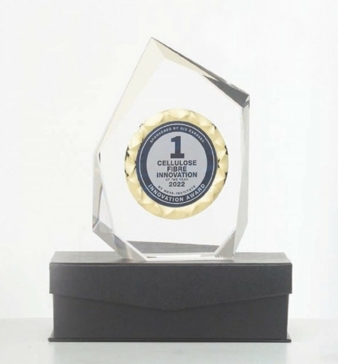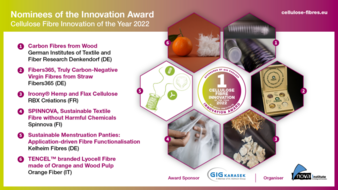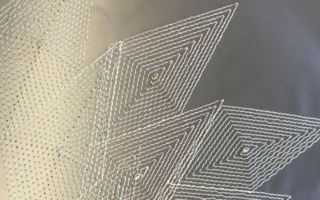25/01/2022 – Award — auf Deutsch lesen
Six nominees for cellulose fibre innovation 2022
For the second time, nova-Institute grants the “Cellulose Fibre Innovation of the Year” at the “International Conference on Cellulose Fibres 2022”.
The six nominees present promising sustainable solutions in the field of cellulose fibres value chain. They now get the chance to demonstrate their full potential to a wide audience in Cologne, Germany, and online from 2–3 February 2022 at the “International Conference on Cellulose Fibres 2022”.
Here are the six nominees
- German Institutes of Textile and Fiber Research Denkendorf, Germany: Carbon fibres from wood
The HighPerCellCarbon technology is a sustainable and alternative process for the production of carbon fibres made from wood. The technology starts with wet spinning of cellulosic fibres using ionic liquids (IL) as direct solvent in an environmentally friendly, closed loop filament spinning process (HighPerCell technology). These filaments are directly converted into carbon fibres by a low-pressure stabilisation process, followed by a suitable carbonisation process. No exhaust fumes or toxic by-products are formed during the whole process. Furthermore, the approach allows a complete recycling of solvent and precursor fibres, creating a unique and environmentally friendly process. Carbon fibres are used in many lightweight applications and the fibres are a sustainable alternative to fossil-based ones.
- Fibers365, Germany: Truly Carbon-negative virgin fibres from straw
Fibers365 are the first carbon-negative virgin straw fibres on the market. The Fibers365 concept is based on a unique, state of the art process to provide functional, carbon negative, and competitive non-wood biomass products such as virgin fibres for paper, packaging and textile purposes as well as high value process energy, biopolymer and fertilizer side streams. The products are extracted from the stems of annual food plants such as straw by a chemical-free, regional, farm level steam explosion pulping technology, allowing an easy separation of the fibres from sugars, lignin, organic acid and minerals. In the case of annual plants, CO2 emissions are recaptured within 12 months from their production date, offering “instant”, yearly compensation of corresponding emissions.
- RBX Créations, France: Iroony hemp and flax cellulose
Iroony is a branded cellulose made by RBX Créations from hemp. This resistant hemp plant grows quickly within in a few months, massively captures carbon and displays a high content of cellulose. The biomass is directly collected from French farmers who cultivate without chemicals or irrigation, in extended rotation cycles, contributing to soil regeneration and biodiversity. For a diversified supply, the hemp can be combined with organically-grown flax. Through its patented process, RBX Créations extracts high-purity cellulose, perfectly suitable for spinning technologies such as HighPerCell of DITF research centre. The resulting fibres display versatile properties of fineness, tenacity and stretch, for applications like clothing or technical textiles. Iroony combines low impact, trackability and performance.
- Spinnova, Finland: Sustainable textile fibre without harmful chemicals
Spinnova’s innovative technology enables production of sustainable textile fibres in a mechanical process, without dissolving or any harmful chemicals. The process involves use of paper-grade pulp and mechanical refining to turn pulp into microfibrillated cellulose (MFC). The fibre suspension consisting of MFC is extruded to form textile fibre, without regeneration processes. The Spinnova process does not generate any side waste, and the environmental footprint of Spinnova including 65 % less CO2 emissions and 99 % less water compared to cotton production. Spinnova’s solution is also scalable: Spinnova targets to reach 1 million tonnes annual production capacity in the next 10 to 12 years.
- Kelheim Fibres, Germany: Sustainable menstruation panties
Kelheim’s plant-based and biodegradable fibres contribute significantly to a sustainable future in the field of reusable hygiene textiles. Through innovative functionalisation they are specifically adjusted to the requirements of the single layers and thereby reach a performance comparable to that of synthetic fibres. A unique duality in fibre technology is created: sustainably manufactured cellulosic fibres that allow for high wearing comfort and reusability with extraordinary, durable performance. Fibre concepts comprise Celliant Viscose, an in-fibre infrared solution and Danufil Fibres in the top sheet, Galaxy, a trilobal fibre for the ADL, Bramante, a hollow viscose fibre, in the absorbing core and a water repellent woven fabric, a biodegradable PLA film or a sustainable coating as a back sheet.
- Orange Fiber, Italy: Tencel branded Lyocell Fibre made of Orange and Wood Pulp
Orange Fiber is the world’s first company to produce a sustainable textile fibre from a patented process for the extraction of cellulose to be spun from citrus juice leftovers, which are more than 1 million tonnes a year just in Italy. The result of our partnership with Lenzing Group, leading global producer of wood-based specialty fibres, is the first ever Tencel branded lyocell fibre made of orange and wood pulp. A novel cellulosic fibre to further inspire sustainability across the value chain and push the boundaries of innovation.
This fibre, part of the Tencel Limited Edition initiative, is characterized by soft appeal and high moisture absorbance and has already obtained the Oeko-Tex Standard 100 certificate and is undergoing a diverse set of other sustainability assessments.
About the conference
Cellulose fibres show an increasingly expanding wide range of applications, while at the same time markets are driven by technological developments and political framework conditions, especially bans and restrictions on plastics and increasing sustainability requirements. The conference provides rich information on opportunities for cellulose fibres through policy assessment, a session on sustainability, recycling and alternative feedstocks as well as latest development in pulp, cellulose fibres and yarns. This includes application such as non-wovens, packaging and composites.





